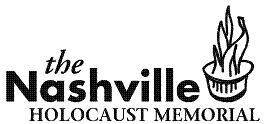“Sometimes we must interfere when human lives are endangered, when human dignity is in jeopardy. National borders and sensitivities become irrelevant, whenever men or women are persecuted because of their race, religion or political views. That place must–at that moment–become the center of the universe.”
Elie Wiesel
1 The Nashville Holocaust Memorial is intended to be a living memorial, a place where remembering and showing respect for the past intermingles with developing an understanding and commitment towards creating a humane future. Our goal is to work towards creating a world where all of us will live free of intolerance, hatred, prejudice and indifference. The circular images represented throughout the Memorial area remind the visitor about the cycle of life and time. We remember and learn from the past; our present actions will determine the future we create.
2 At the entrance to the Memorial, the visitor will find the Hebrew word “Zachor”—Remember. As one takes the first step into the Memorial area, this marker urges us to remember those whose lives were shattered because of the Holocaust and the extent that hatred can make one inhumane. The Memorial is intended to honor those who were victims of the Holocaust. The Hebrew date 5766, corresponds to the current year in which the Memorial is dedicated.
3 The first rest stop along the path provides an opportunity to become acquainted with the Nashville Survivor and Refugee community. This wall recognizes the array of places and countries from which they came. These individuals are real people who had real lives before Hitler came to power. Their families were destroyed and their lives changed forever. All found their way to Nashville to become citizens, raise families and participate in the life of the community, but they will never be able to forget what happened to them. The next rest area bears a wall whose messages encourage the visitor to consider one’s personal responsibility to the determination of history and our fellow humankind. What is the responsibility of each of us to the future and each other in the face of injustice and discrimination?
4 As the visitor enters the main Memorial Plaza, there are a number of significant areas to note. The 12 Memorial Walls bear the names of loved ones who were the victims and intended victims of Nazi Genocide. Their names and information were placed there by their families and friends as a way to honor and remember them. For some, this Memorial is their only place of remembrance, having perished at the hands of Nazi oppression with no grave.
Under the names, there is a small ledge where personal thoughts and prayers may be placed. It is a spot where stones may be left. This is a Jewish tradition indicating that one has visited the memorial site of a loved one.
5 The focal point of the Plaza is the Sculpture. The book with torn and missing pages represents the destruction of two-thirds of European Jewry. Of the estimated nine million Jewish people living in Europe prior to 1933, six million were murdered in the Holocaust. Before the sculpture is a “Ner Tamid,” an eternal light. This light shines to represent a symbol of faith.
6 The first rest stop along the path provides an opportunity to become acquainted with the Nashville Survivor and Refugee community. This wall recognizes the array of places and countries from which they came. These individuals are real people who had real lives before Hitler came to power. Their families were destroyed and their lives changed forever. All found their way to Nashville to become citizens, raise families and participate in the life of the community, but they will never be able to forget what happened to them. The next rest area bears a wall whose messages encourage the visitor to consider one’s personal responsibility to the determination of history and our fellow humankind. What is the responsibility of each of us to the future and each other in the face of injustice and discrimination?
7 On the ends of tables near the back of the Plaza, we recognize and thank our major donors for their help in creating this Memorial. Without them….this dream could not have become a reality.
8 The central quote by Elie Wiesel, speaks to the sincere intent in creating this Memorial. “When any one becomes the victim of hatred and persecution we must not and cannot turn away. The price for indifference is too high.”

